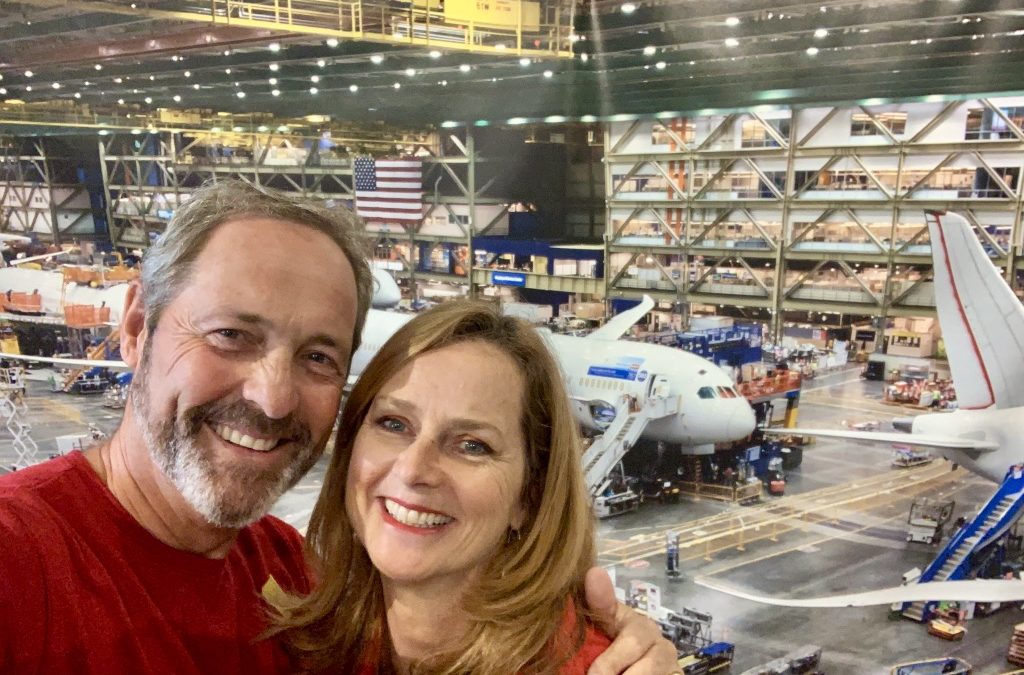Who is driving the customer experience at Boeing?
Boeing is in the news. In its 103-year history, it is probably facing the greatest challenges it ever has. Some commentators are asking ‘will it survive’? The customer experience and the brand reputation are being challenged (to say the least).
I wanted to know more about this business, which surprised my husband when I jumped at the chance to visit the ‘factory.’ I’m fascinated by business and customer experience – and being able to tour the world’s largest building (the Boeing facility in Seattle Washington) was too good an opportunity to miss. A range of wide-bodied commercial aircraft have been built at this location for just over fifty years; since the first 747 emerged.
Who is the customer and who influences the customer experience?
In those fifty years, Boeing has been inviting guests to view its facility – and more than five million people have taken the tour. An average of 100,000 people every year hear the Boeing story and witness the building of aircraft.
Most people on the planet will never be a ‘customer’ as such, ie purchase an aeroplane. However, there are many stakeholders – from airline staff to passengers – who ultimately are very much a part of the Boeing brand story. And this is who Boeing hosts day in and day out.
It is a way for Boeing to listen, learn and get closer to its stakeholders (customers).
Many online businesses are building ‘popups’ or showrooms (we attend exhibitions and tradeshows) as a way to interact with the customer and listen to stakeholder feedback. It is the conversations, ideas and insights that come from these formal and informal interactions that can often provide the greatest opportunities to learn and evolve. To ensure that the business stays relevant and connected.
All business leaders must find new ways to listen and learn from their stakeholders.
Amazon host office tours in Seattle, as does Zappos in Las Vegas. And back in the day, we would host tours and lunches for different groups through the RedBalloon offices – from politicians to students and professional groups.
The tour of Boeing was extremely well-produced (read: orchestrated) and it gave us an opportunity to ‘feel’ something for the brand – to ‘be a part of’ the bigger story. It provided us with an experience of the Boeing ‘personality’ and an understanding of the original vision that drives the business.
There are 35,000 employees located at this facility; each accountable for his or her role in making sure the 50 million components that arrive each month end up in the right place at the right time in the right hands.
Customer airlines are who purchase these aircraft (for about $450m each), and we were told on the tour how Boeing changed the way it listened to those customers as part of the development of the Dreamliner.
This was a new approach to the customer experience by Boeing.
The result:
- The move to carbon fibre away from aluminium sheets meant that the new aircraft was not only stronger but lighter, which massively improved fuel efficiency
- Of the 600,000 components in an aircraft, 300,000 of those were rivets. With carbon fibre, the same quantity is no longer needed
- The increased strength means the windows are larger (and higher) so every passenger can see the horizon
- The air is pressurised differently and of better quality, making for a more comfortable and healthier flying experience.
Every element of the human experience in creating the new jets was tested with the 30 or so airline customers. Boeing listened to the customer (and stakeholder) experience as part of its design process.
Each of those 30 customer airlines liveries is emblazoned on the wall of the facility where the Dreamliner’s are being built. Reminding every team member of the customers they serve.
The Boeing purpose is ‘Connect, Protect, Explore and Inspire the World through Aerospace Innovation’. This purpose unites employees to a cause bigger than building aircraft.
Two take-outs from the site visit:
- Involve all your stakeholders in your story – let them be a part of your journey, help them become advocates of your brand
- Create ways for customers to provide input into product development.
This was a pretty slick PR operation, and the tour finished in the gift shop – with plenty of merchandise on offer so that the 100,000 guests a year can also become billboards for the brand.
There are massive lawsuits against Boeing right now. And it is not for me to comment on those. But what I do see is that many startups and smaller businesses can learn from this big ‘old’ enterprise on how to stay close and listen to the customer experience, whilst engaging stakeholders as brand advocates.
Naomi Simson entrepreneur co-founded The Big Red Group in 2017 which includes brands such as RedBalloon, Adrenaline, IfOnly and Redii.com. She has been blogging for a decade at NaomiSimson.com, is a professional speaker, author of Live What You Love & Ready To Soar, and a “Shark” on business reality show Shark Tank Australia.
Also published on Medium.

